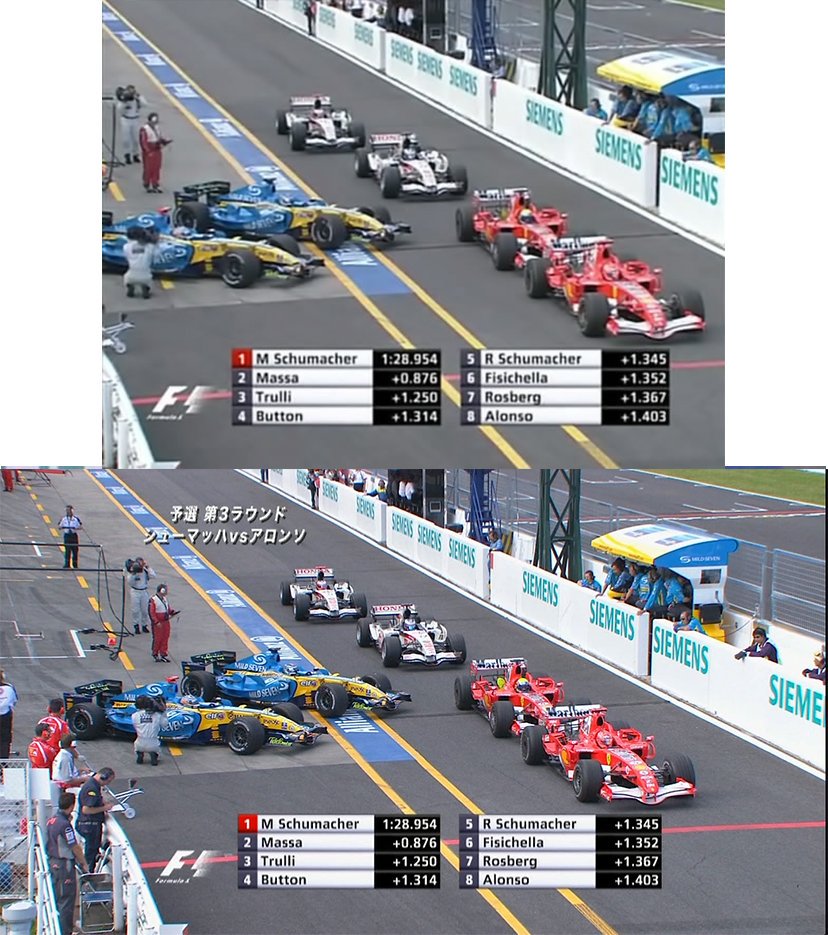2018
- A new red & black graphics package was introduced.
2017
- A 4K Ultra HD version of the feed was now made available to broadcasters.
2015
- A new graphics package was introduced, featuring a “flatter” look and feel.
2012
- FOM made a 5.1 surround sound mix available to broadcasters taking the HD feed.
- FOM took over production of the World Feed for the following race, taking the total of FOM-produced rounds to 19 out of 20:
- Japan
- Only the Monaco Grand Prix is now produced by someone other than FOM, namely the Monegasque broadcaster TMC
2011
- An HD version of the feed was now made available to broadcasters for all rounds.
2010
- A new slanted, black graphics set was introduced.
2009
- The 2004 graphics set was updated, giving the graphics a bevelled, “3D” look. The graphics for the 16:9 version of the feed started to encroach out of the 4:3-safe area.
2008
- FOM took over production of the World Feed for the following race, taking the total of FOM-produced rounds to 16 out of 18:
- Brazil
2007
- The world feed for every round was now both produced and made available to broadcasters in 16:9 widescreen. Graphics remained within the 4:3-safe area.
- FOM took over production of the World Feed for the following races, taking the total of FOM-produced rounds to 15 out of 17:
- Spain
- France
- Britain
- Europe
- Hungary
- Italy
- Belgium
2006

Top: SD Feed (International)
Bottom: HD Feed (Japan only)
- For the 2006 Japanese Grand Prix, host broadcaster Fuji TV filmed the event in 1080i High Definition, with up-scaled FOM graphics & burnt-in Japanese graphics. International viewers saw an SD downscale of the feed, minus the Japanese graphics. This continued up until 2012 when FOM took over production of the event.
2005
- FOM took over production of the World Feed for the following races, taking the total of FOM-produced rounds to 7 out of 19:
- Canada
- United States
- For the 2005 Belgian Grand Prix, host broadcaster RTBF filmed the race in 16:9 widescreen (seemingly as an internal trial), however both domestic and international viewers saw the feed cropped to 4:3.
2004
- Starting in 2004, FOM took over production of the World Feed at certain races, producing the World Feed for 4 of the 18 rounds that year:
- Australia
- Malaysia
- Bahrain
- China
- A new black-on-white graphics set was introduced.
- The world feed began to feature team radio broadcasts
2001-2003
- For the Australian Grand Prix during these years, the World Feed was filmed by the host broadcasters Nine Network (2001 & 2002) and Network Ten (2003) in 16:9 widescreen. The widescreen version of the feed was only shown to Australian viewers watching in digital. Australian viewers watching in analogue got a 14:9 crop, and international viewers got a 4:3 crop.
- For the 2002 United States Grand Prix, the World Feed used the F1 Digital+ ‘Super’ feed.
1997-1999
- For the Brazilian Grand Prix during these years, the World Feed was taken from the F1 Digital+ ‘Super’ feed, minus F1 Digital’s exclusive graphics and additional on-board angles.
1996
- After a trial at the 1996 British Grand Prix, the F1 Digital+ package was officially launched at the 1996 German Grand Prix. For more information, see the F1 Digital+ section of this website.
1994
- For the 1994 season, FOM introduced the famous black & yellow graphics package.
- The language of the graphics was now in English, regardless of where the Grand Prix was taking place.
1991
- From part-way through 1991 until the end of the 1993 season, the World Feed used an (EBU?) graphics package that was used across a variety of sports from that period, not just F1.
- The language of the graphics was the official language of wherever the Grand Prix was taking place that weekend.
- Used sporadically in 1991, the package was used more frequently during 1992 to 1993.